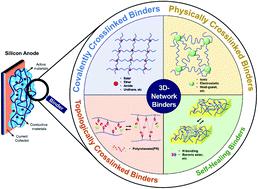当前位置:
X-MOL 学术
›
J. Mater. Chem. A
›
论文详情
Our official English website, www.x-mol.net, welcomes your feedback! (Note: you will need to create a separate account there.)
Progress of 3D network binders in silicon anodes for lithium ion batteries
Journal of Materials Chemistry A ( IF 11.9 ) Pub Date : 2020-11-02 , DOI: 10.1039/d0ta07713e Anjali N. Preman 1, 2, 3, 4 , Hyocheol Lee 1, 2, 3, 4 , Jungwoo Yoo 4, 5, 6, 7 , Il Tae Kim 4, 8, 9, 10 , Tomonori Saito 11, 12, 13, 14 , Suk-kyun Ahn 1, 2, 3, 4
Journal of Materials Chemistry A ( IF 11.9 ) Pub Date : 2020-11-02 , DOI: 10.1039/d0ta07713e Anjali N. Preman 1, 2, 3, 4 , Hyocheol Lee 1, 2, 3, 4 , Jungwoo Yoo 4, 5, 6, 7 , Il Tae Kim 4, 8, 9, 10 , Tomonori Saito 11, 12, 13, 14 , Suk-kyun Ahn 1, 2, 3, 4
Affiliation

|
Prompted by its overwhelming benefits, silicon (Si) has evolved as one of the most promising anode materials for high-capacity lithium-ion batteries (LIBs). However, some of the intrinsic drawbacks such as low ionic conductivity and inevitable volume change during the alloying/dealloying process seriously hamper the commercialization of Si-based anodes in LIBs. Among the several strategies to overcome the challenges of the Si anode, the development of designed polymeric binders is imperative for enabling stable and satisfactory performance. The improved cell performance due to the designed binders is recognized as an economical and practical approach, especially from the industrial perspective. In addition to their conventional role in integrating electrode components, binders also play a significant role in alleviating the unfavorable phenomenon of volume expansion, and ultimately stabilizing the Si anode and Si-electrolyte interphase. The polymer architecture of the binders significantly influences the binder performance, and three-dimensional (3D) network binders are generally more effective at coping with the stress resulting from the huge volume change of the Si anode. To develop advanced 3D binders, substantial research efforts have been made including various crosslinking strategies in the past decade. In this review, we focus on diverse crosslinking methods including chemical-, physical-, and topological-crosslinking for rationally designing network binders for Si anodes and take a glance at dynamic interactions to construct healable binders for long-term stability.
中文翻译:

锂离子电池硅阳极中3D网络粘合剂的研究进展
凭借其压倒性的优势,硅(Si)已发展成为大容量锂离子电池(LIB)最具前景的负极材料之一。但是,某些固有的缺陷,例如低离子电导率和合金化/脱合金过程中不可避免的体积变化,严重阻碍了LIB中Si基阳极的商业化。在克服硅阳极挑战的几种策略中,设计聚合物粘合剂的开发对于实现稳定和令人满意的性能至关重要。由于设计了粘合剂,改进的电池性能被认为是一种经济实用的方法,特别是从工业角度而言。除了在集成电极组件方面的常规作用外,粘合剂在减轻不利的体积膨胀现象以及最终稳定硅阳极和硅电解质中间相方面也起着重要作用。粘合剂的聚合物结构显着影响粘合剂的性能,三维(3D)网络粘合剂通常更有效地应对由Si阳极体积变化引起的应力。为了开发高级3D粘合剂,在过去的十年中,已经进行了大量的研究工作,包括各种交联策略。在这篇综述中,我们专注于多种交联方法,包括化学,物理和拓扑交联,以合理设计用于Si阳极的网络粘合剂,并对动态相互作用一目了然,以构建可修复的粘合剂以获得长期稳定性。并最终稳定了硅阳极和硅电解质的中间相。粘合剂的聚合物结构显着影响粘合剂的性能,三维(3D)网络粘合剂通常更有效地应对由Si阳极体积变化带来的应力。为了开发高级3D粘合剂,在过去的十年中,已经进行了大量的研究工作,包括各种交联策略。在这篇综述中,我们专注于多种交联方法,包括化学,物理和拓扑交联,以合理设计用于Si阳极的网络粘合剂,并对动态相互作用一目了然,以构建可修复的粘合剂以获得长期稳定性。并最终稳定了硅阳极和硅电解质的中间相。粘合剂的聚合物结构显着影响粘合剂的性能,三维(3D)网络粘合剂通常更有效地应对由Si阳极体积变化引起的应力。为了开发先进的3D粘合剂,在过去的十年中,已经进行了大量的研究工作,包括各种交联策略。在这篇综述中,我们专注于多种交联方法,包括化学,物理和拓扑交联,以合理设计用于Si阳极的网络粘合剂,并对动态相互作用一目了然,以构建可修复的粘合剂以获得长期稳定性。粘合剂的聚合物结构显着影响粘合剂的性能,三维(3D)网络粘合剂通常更有效地应对由Si阳极体积变化引起的应力。为了开发高级3D粘合剂,在过去的十年中,已经进行了大量的研究工作,包括各种交联策略。在这篇综述中,我们专注于多种交联方法,包括化学,物理和拓扑交联,以合理设计用于Si阳极的网络粘合剂,并对动态相互作用一目了然,以构建可修复的粘合剂以获得长期稳定性。粘合剂的聚合物结构显着影响粘合剂的性能,三维(3D)网络粘合剂通常更有效地应对由Si阳极体积变化引起的应力。为了开发高级3D粘合剂,在过去的十年中,已经进行了大量的研究工作,包括各种交联策略。在这篇综述中,我们专注于多种交联方法,包括化学,物理和拓扑交联,以合理设计用于Si阳极的网络粘合剂,并对动态相互作用一目了然,以构建可修复的粘合剂以获得长期稳定性。在过去的十年中,已经进行了大量的研究工作,包括各种交联策略。在这篇综述中,我们专注于多种交联方法,包括化学,物理和拓扑交联,以合理设计用于Si阳极的网络粘合剂,并对动态相互作用一目了然,以构建可修复的粘合剂以获得长期稳定性。在过去的十年中,已经进行了大量的研究工作,包括各种交联策略。在这篇综述中,我们专注于多种交联方法,包括化学,物理和拓扑交联,以合理设计用于Si阳极的网络粘合剂,并对动态相互作用一目了然,以构建可修复的粘合剂以获得长期稳定性。
更新日期:2020-11-25
中文翻译:

锂离子电池硅阳极中3D网络粘合剂的研究进展
凭借其压倒性的优势,硅(Si)已发展成为大容量锂离子电池(LIB)最具前景的负极材料之一。但是,某些固有的缺陷,例如低离子电导率和合金化/脱合金过程中不可避免的体积变化,严重阻碍了LIB中Si基阳极的商业化。在克服硅阳极挑战的几种策略中,设计聚合物粘合剂的开发对于实现稳定和令人满意的性能至关重要。由于设计了粘合剂,改进的电池性能被认为是一种经济实用的方法,特别是从工业角度而言。除了在集成电极组件方面的常规作用外,粘合剂在减轻不利的体积膨胀现象以及最终稳定硅阳极和硅电解质中间相方面也起着重要作用。粘合剂的聚合物结构显着影响粘合剂的性能,三维(3D)网络粘合剂通常更有效地应对由Si阳极体积变化引起的应力。为了开发高级3D粘合剂,在过去的十年中,已经进行了大量的研究工作,包括各种交联策略。在这篇综述中,我们专注于多种交联方法,包括化学,物理和拓扑交联,以合理设计用于Si阳极的网络粘合剂,并对动态相互作用一目了然,以构建可修复的粘合剂以获得长期稳定性。并最终稳定了硅阳极和硅电解质的中间相。粘合剂的聚合物结构显着影响粘合剂的性能,三维(3D)网络粘合剂通常更有效地应对由Si阳极体积变化带来的应力。为了开发高级3D粘合剂,在过去的十年中,已经进行了大量的研究工作,包括各种交联策略。在这篇综述中,我们专注于多种交联方法,包括化学,物理和拓扑交联,以合理设计用于Si阳极的网络粘合剂,并对动态相互作用一目了然,以构建可修复的粘合剂以获得长期稳定性。并最终稳定了硅阳极和硅电解质的中间相。粘合剂的聚合物结构显着影响粘合剂的性能,三维(3D)网络粘合剂通常更有效地应对由Si阳极体积变化引起的应力。为了开发先进的3D粘合剂,在过去的十年中,已经进行了大量的研究工作,包括各种交联策略。在这篇综述中,我们专注于多种交联方法,包括化学,物理和拓扑交联,以合理设计用于Si阳极的网络粘合剂,并对动态相互作用一目了然,以构建可修复的粘合剂以获得长期稳定性。粘合剂的聚合物结构显着影响粘合剂的性能,三维(3D)网络粘合剂通常更有效地应对由Si阳极体积变化引起的应力。为了开发高级3D粘合剂,在过去的十年中,已经进行了大量的研究工作,包括各种交联策略。在这篇综述中,我们专注于多种交联方法,包括化学,物理和拓扑交联,以合理设计用于Si阳极的网络粘合剂,并对动态相互作用一目了然,以构建可修复的粘合剂以获得长期稳定性。粘合剂的聚合物结构显着影响粘合剂的性能,三维(3D)网络粘合剂通常更有效地应对由Si阳极体积变化引起的应力。为了开发高级3D粘合剂,在过去的十年中,已经进行了大量的研究工作,包括各种交联策略。在这篇综述中,我们专注于多种交联方法,包括化学,物理和拓扑交联,以合理设计用于Si阳极的网络粘合剂,并对动态相互作用一目了然,以构建可修复的粘合剂以获得长期稳定性。在过去的十年中,已经进行了大量的研究工作,包括各种交联策略。在这篇综述中,我们专注于多种交联方法,包括化学,物理和拓扑交联,以合理设计用于Si阳极的网络粘合剂,并对动态相互作用一目了然,以构建可修复的粘合剂以获得长期稳定性。在过去的十年中,已经进行了大量的研究工作,包括各种交联策略。在这篇综述中,我们专注于多种交联方法,包括化学,物理和拓扑交联,以合理设计用于Si阳极的网络粘合剂,并对动态相互作用一目了然,以构建可修复的粘合剂以获得长期稳定性。



























 京公网安备 11010802027423号
京公网安备 11010802027423号